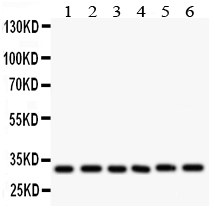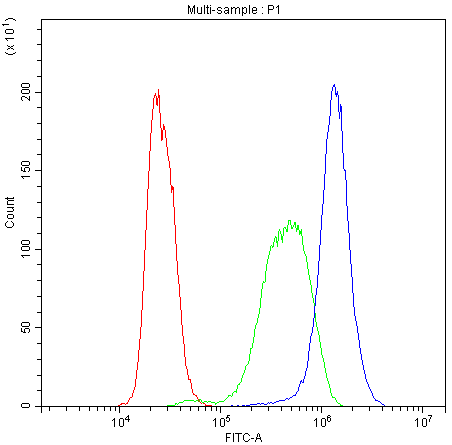Product Info Summary
| SKU: | PA1849 |
|---|---|
| Size: | 100 μg/vial |
| Reactive Species: | Human, Mouse, Rat |
| Host: | Rabbit |
| Application: | WB |
Customers Who Bought This Also Bought
Product info
Product Name
Anti-Caspase 3/CASP3 Antibody Picoband®
SKU/Catalog Number
PA1849
Size
100 μg/vial
Form
Lyophilized
Description
Boster Bio Anti-Caspase 3/CASP3 Antibody catalog # PA1849. Tested in WB applications. This antibody reacts with Human, Mouse, Rat. The brand Picoband indicates this is a premium antibody that guarantees superior quality, high affinity, and strong signals with minimal background in Western blot applications. Only our best-performing antibodies are designated as Picoband, ensuring unmatched performance.
Storage & Handling
Store at -20˚C for one year from date of receipt. After reconstitution, at 4˚C for one month. It can also be aliquotted and stored frozen at -20˚C for six months. Avoid repeated freeze-thaw cycles.
Cite This Product
Anti-Caspase 3/CASP3 Antibody Picoband® (Boster Biological Technology, Pleasanton CA, USA, Catalog # PA1849)
Host
Rabbit
Contents
Each vial contains 4 mg Trehalose, 0.9 mg NaCl and 0.2mg Na2HPO4.
Clonality
Polyclonal
Isotype
Rabbit IgG
Immunogen
A synthetic peptide corresponding to a sequence at the C-terminal of human Caspase 3, identical to the related mouse sequence, and different from the related rat sequence by one amino acid.
*Blocking peptide can be purchased. Costs vary based on immunogen length. Contact us for pricing.
Cross-reactivity
No cross-reactivity with other proteins
Reactive Species
PA1849 is reactive to CASP3 in Human, Mouse, Rat
Reconstitution
Add 0.2ml of distilled water will yield a concentration of 500ug/ml.
Observed Molecular Weight
31 kDa
Calculated molecular weight
31608 MW
Background of Caspase-3
Caspase 3 (caspase 3, apoptosis-related cysteine peptidase) is a caspase protein that interacts with caspase 8 and caspase 9, also known as Caspase-3, PARP CLEAVAGE PROTEASE, APOPAIN, CPP32, CPP32B, YAMA. It is a member of the cysteine-aspartic acid protease (caspase) family. PCR analysis of 16 human tissues revealed expression of full-length CASP3, as well as CASP3s at somewhat lower levels, in all tissues tested. Western blot analysis of 3 cell lines revealed the prominent CASP3 band at 32 kD and CASP3s at 20 kD. Several human cancer cell lines showed coexpression of both variants at the mRNA and protein levels. Overexpression of the catalytically inactive CASP3s by human kidney cells offered some resistance to inducers of apoptosis, and CASP3s accumulation could be enhanced with addition of proteasome inhibitors. Sequential activation of caspases plays a central role in the execution-phase of cell apoptosis. Alternative splicing of this gene results in two transcript variants that encode the same protein. Encoded by the CASP3 gene, CASP3 orthologs have been identified in numerous mammals for which complete genome data are available. Unique orthologs are also present in birds, lizards, lissamphibians, and teleosts. Nicholson et al. developed a potent peptide aldehyde inhibitor and showed that it prevented apoptotic events in vitro, suggesting that apopain/CPP32 is important for the initiation of apoptotic cell death.
Antibody Validation
Boster validates all antibodies on WB, IHC, ICC, Immunofluorescence, and ELISA with known positive control and negative samples to ensure specificity and high affinity, including thorough antibody incubations.
Application & Images
Applications
PA1849 is guaranteed for WB Boster Guarantee
Assay Dilutions Recommendation
The recommendations below provide a starting point for assay optimization. The actual working concentration varies and should be decided by the user.
Western blot, 0.1-0.5μg/ml, Human, Rat, Mouse
Positive Control
WB: Rat Cardiac Muscle Tissue, Rat Liver Tissue, Rat Thymus Tissue, MCF-7 Whole Cell, SMMC Whole Cell, HT1080 Whole Cell
Validation Images & Assay Conditions

Click image to see more details
Anti-CASP3 antibody, PA1849, Western blotting
All lanes: Anti CASP3 (PA1849) at 0.5ug/ml
Lane 1: Rat Cardiac Muscle Tissue Lysate at 50ug
Lane 2: Rat Liver Tissue Lysate at 50ug
Lane 3: Rat Thymus Tissue Lysate at 50ug
Lane 4: MCF-7 Whole Cell Lysate at 40ug
Lane 5: SMMC Whole Cell Lysate at 40ug
Lane 6: HT1080 Whole Cell Lysate at 40ug
Predicted bind size: 31KD
Observed bind size: 31KD
Protein Target Info & Infographic
Gene/Protein Information For CASP3 (Source: Uniprot.org, NCBI)
Gene Name
CASP3
Full Name
Caspase-3
Weight
31608 MW
Superfamily
peptidase C14A family
Alternative Names
Caspase-3;CASP-3;3.4.22.56;Apopain;Cysteine protease CPP32;CPP-32;Protein Yama;SREBP cleavage activity 1;SCA-1;Caspase-3 subunit p17;Caspase-3 subunit p12;CASP3;CPP32; CASP3 CPP32, CPP32B, SCA-1 caspase 3 caspase-3|CASP-3|CPP-32|PARP cleavage protease|SREBP cleavage activity 1|apopain|caspase 3, apoptosis-related cysteine peptidase|caspase 3, apoptosis-related cysteine protease|cysteine protease CPP32|procaspase3|protein Yama
*If product is indicated to react with multiple species, protein info is based on the gene entry specified above in "Species".For more info on CASP3, check out the CASP3 Infographic

We have 30,000+ of these available, one for each gene! Check them out.
In this infographic, you will see the following information for CASP3: database IDs, superfamily, protein function, synonyms, molecular weight, chromosomal locations, tissues of expression, subcellular locations, post-translational modifications, and related diseases, research areas & pathways. If you want to see more information included, or would like to contribute to it and be acknowledged, please contact [email protected].
Specific Publications For Anti-Caspase 3/CASP3 Antibody Picoband® (PA1849)
Hello CJ!
PA1849 has been cited in 116 publications:
*The publications in this section are manually curated by our staff scientists. They may differ from Bioz's machine gathered results. Both are accurate. If you find a publication citing this product but is missing from this list, please let us know we will issue you a thank-you coupon.
Effects of Calcitonin Gene-related Peptide on Dental Pulp Stem Cell Viability, Proliferation, and Differentiation
Lu Kong,Yongya Wu,Wangcheng Hu,Lin Liu,Yuying Xue,Geyu Liang,Mechanisms underlying reproductive toxicity induced by nickel nanoparticles identified by comprehensive gene expression analysis in GC-1 spg cells,Environmental Pollution,2021,116556,ISSN 0269-7
Species: Mouse
PA1849 usage in article: APP:WB, SAMPLE:GC-1 CELL, DILUTION:1:1000
Gang Li,Jing Zhou,Mengyu Sun,Juren Cen,Jing Xu,Role of luteolin extracted from Clerodendrum cyrtophyllum Turcz leaves in protecting HepG2 cells from TBHP-induced oxidative stress and its cytotoxicity, genotoxicity,Journal of Functional Foods, Volume 74, 2
Species: Human
PA1849 usage in article: APP:WB, SAMPLE:HEPG-2 CELL, DILUTION:1:2000
Yu Y,Wang Y,Fei X,Song Z,Xie F,Yang F,Liu X,Xu Z,Wang G.All-Trans Retinoic Acid Prevented Vein Grafts Stenosis by Inhibiting Rb-E2F Mediated Cell Cycle Progression and KLF5-RARα Interaction in Human Vein Smooth Muscle Cells.Cardiovasc Drugs Ther.2020 Oct
Species: Human,New Zealand White Rabbit
PA1849 usage in article: APP:WB, SAMPLE:HUVMSCS, DILUTION:1:1000
Liu L,Liu F,Sun Z,Peng Z,You T,Yu Z. LncRNA NEAT1 promotes apoptosis and inflammation in LPS-induced sepsis models by targeting miR-590-3p. Exp Ther Med.2020 Oct; 20(4):3290-3300. doi:10.3892/etm.2020.9079. Epub 2020 Jul 29.PMID:32855700;PMCID:PMC7444425.
Species: Human
PA1849 usage in article: APP:WB, SAMPLE:H9C2 CELL, DILUTION:1:1000
Chen H,Sheng H,Zhao Y,Zhu G.Piperine Inhibits Cell Proliferation and Induces Apoptosis of Human Gastric Cancer Cells by Downregulating Phosphatidylinositol 3-Kinase (PI3K)/Akt Pathway.Med Sci Monit.2020 Dec 31;26:e928403.doi:10.12659/MSM.928403.PMID:33382
Species: Human,Mouse
PA1849 usage in article: APP:WB, SAMPLE:SNU-16 CELL, DILUTION:NA
Sun K,Luo J,Jing X,Xiang W,Guo J,Yao X,Liang S,Guo F,Xu T.Hyperoside ameliorates the progression of osteoarthritis: An in vitro and in vivo study.Phytomedicine.2020 Oct 14;80:153387.doi:10.1016/j.phymed.2020. 153387.Epub ahead of print.PMID:33130473.
Species: Mouse
Wei JL,Wu CJ,Chen JJ,Shang FT,Guo SG,Zhang XC,Liu H.LncRNA NEAT1 promotes the progression of sepsis-induced myocardial cell injury by sponging miR-144-3p.Eur Rev Med Pharmacol Sci.2020 Jan;24(2):851-861.doi:10.26355/eurrev_202001_20069.PMID:32016991.
Species: Mouse
PA1849 usage in article: APP:WB, SAMPLE:HL-1 CELLS, DILUTION:1:1000
Zhu X,Yao Y,Yang J,Zhengxie J,Li X,Hu S,Zhang A,Dong J,Zhang C,Gan G.COX-2-PGE2 signaling pathway contributes to hippocampal neuronal injury and cognitive impairment in PTZ-kindled epilepsy mice. Int Immunopharmacol. 2020 Oct;87:106801.doi: 10.1016/j.inti
Species: Mouse
PA1849 usage in article: APP:WB, SAMPLE:HIPPOCAMPUL TISSUE, DILUTION:1:2500
Recommended Resources
Here are featured tools and databases that you might find useful.
- Boster's Pathways Library
- Protein Databases
- Bioscience Research Protocol Resources
- Data Processing & Analysis Software
- Photo Editing Software
- Scientific Literature Resources
- Research Paper Management Tools
- Molecular Biology Software
- Primer Design Tools
- Bioinformatics Tools
- Phylogenetic Tree Analysis
Customer Reviews
Have you used Anti-Caspase 3/CASP3 Antibody Picoband®?
Submit a review and receive an Amazon gift card.
- $30 for a review with an image
0 Reviews For Anti-Caspase 3/CASP3 Antibody Picoband®
Customer Q&As
Have a question?
Find answers in Q&As, reviews.
Can't find your answer?
Submit your question
4 Customer Q&As for Anti-Caspase 3/CASP3 Antibody Picoband®
Question
We have seen staining in rat lymph. Are there any suggestions? Is anti-Caspase 3/CASP3 antibody supposed to stain lymph positively?
Verified Customer
Verified customer
Asked: 2019-12-11
Answer
Based on literature lymph does express CASP3. Based on Uniprot.org, CASP3 is expressed in jejunal mucosa, t-cell, tongue, lymph, cervix carcinoma erythroleukemia, among other tissues. Regarding which tissues have CASP3 expression, here are a few articles citing expression in various tissues:
Cervix carcinoma, and Erythroleukemia, Pubmed ID: 23186163
Lymph, Pubmed ID: 15489334
T-cell, Pubmed ID: 7983002, 7774019
Tongue, Pubmed ID: 14702039
Boster Scientific Support
Answered: 2019-12-11
Question
Our lab were happy with the WB result of your anti-Caspase 3/CASP3 antibody. However we have been able to see positive staining in t-cell cytoplasm. using this antibody. Is that expected? Could you tell me where is CASP3 supposed to be expressed?
D. Jones
Verified customer
Asked: 2019-12-11
Answer
According to literature, t-cell does express CASP3. Generally CASP3 expresses in cytoplasm. Regarding which tissues have CASP3 expression, here are a few articles citing expression in various tissues:
Cervix carcinoma, and Erythroleukemia, Pubmed ID: 23186163
Lymph, Pubmed ID: 15489334
T-cell, Pubmed ID: 7983002, 7774019
Tongue, Pubmed ID: 14702039
Boster Scientific Support
Answered: 2019-12-11
Question
We need using your anti-Caspase 3/CASP3 antibody for wound healing studies. Has this antibody been tested with western blotting on ht1080 whole cell lysate? We would like to see some validation images before ordering.
Verified Customer
Verified customer
Asked: 2019-06-13
Answer
Thank you for your inquiry. This PA1849 anti-Caspase 3/CASP3 antibody is validated on rat thymus tissue, cardiac muscle tissue, tissue lysate, liver tissue, smmc whole cell lysate, ht1080 whole cell lysate. It is guaranteed to work for WB in human, mouse, rat. Our Boster guarantee will cover your intended experiment even if the sample type has not been be directly tested.
Boster Scientific Support
Answered: 2019-06-13
Question
We are currently using anti-Caspase 3/CASP3 antibody PA1849 for mouse tissue, and we are happy with the WB results. The species of reactivity given in the datasheet says human, mouse, rat. Is it possible that the antibody can work on bovine tissues as well?
P. Krishna
Verified customer
Asked: 2019-05-10
Answer
The anti-Caspase 3/CASP3 antibody (PA1849) has not been validated for cross reactivity specifically with bovine tissues, though there is a good chance of cross reactivity. We have an innovator award program that if you test this antibody and show it works in bovine you can get your next antibody for free. Please contact me if I can help you with anything.
Boster Scientific Support
Answered: 2019-05-10





